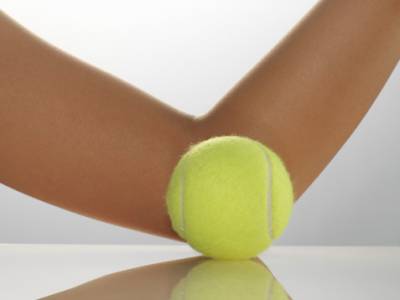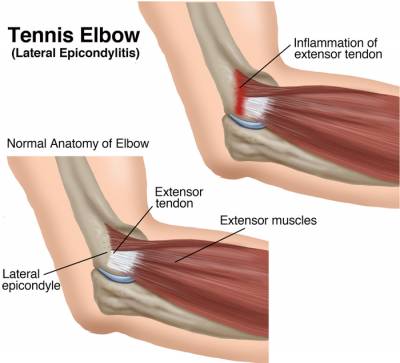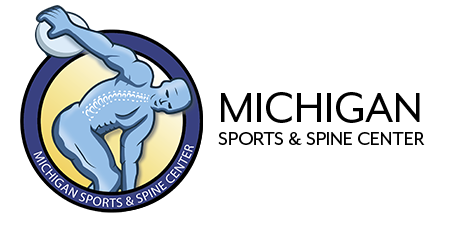Tennis Elbow – Ease Your Pain at Home

Tennis elbow or lateral epicondylitis is a common injury causing pain on the outside of the elbow.
Despite its name, this condition is not commonly seen in tennis players but more in work related elbow injuries particularly where repetitive stress is involved. Symptoms can be similar to those of other elbow injuries so it is important to get a correct diagnosis early on.
SYMPTOMS
•Pain about 1 to 2 cm down from the bony part on the outside of the elbow called the lateral epicondyle.
•Weakness in the wrist with difficulty doing simple tasks such as opening a door handle or holding a cup in your hand.
•Pain is reproduced when pressing just below the lateral epicondyle on the outside of the elbow as well as when trying to straighten or extend the hand and fingers against resistance.
ANATOMY
Tennis elbow occurs most commonly in the tendon of the Extensor carpi radialis brevis muscle as it inserts into the bony bit on the outside of the humerus. This is an increase in pain receptors making the region extremely tender.
CAUSES
The most common cause is overuse or repetitive strain caused by repeated extension or bending back of the wrist against resistance. Gripping heavy objects like a hammer, weight training or any activity that requires excessive constant gripping or squeezing can cause tennis elbow.
TREATMENT
No single treatment has been shown to be totally effective, however a combination of the treatments below are known to resolve tennis elbow over time. Each individual will react differently to different treatments.
REST AND ICE
Rest is important to allow the tissues to heal. Activities which place a large strain on the elbow should all be avoided if possible. Applying ice or cold therapy to the elbow (15 mins up to six times a day) to reduce pain and inflammation is a good start, particularly in the early days when the elbow is acutely painful. Ice can also be applied after rehabilitation exercises.
EXERCISES
Both stretching and strengthening exercises are important and provide the main element of a rehabilitation program. Exercises should be done as soon as pain allows and continued after full fitness has been achieved. Wrist extension exercises are most important where the aim is to gradually increase the load through the tendon so it can cope with what is being demanded of it but within the limits of pain.
Stretching
This should start as soon as possible and be continued throughout rehabilitation and beyond. The muscles specifically involved in the rehabilitation of tennis elbow can be stretched by placing the arm out straight in front, palm down and gently pull the hand towards you. Rotating the forearm inwards can increase the stretch. Held for 20 seconds and repeated up to 5 times.
Strengthening
Strengthening exercises usually begin with isometric or static exercises. This means contracting the muscles without actually moving the wrist or hand. These should be started as soon as pain allows but if they are painful to perform then wait. The arm is positioned with the palm and forearm facing down. Aim to extend the wrist (lift it upwards) against resistance which can either be your hand or the therapists. Maintain the contraction for 5 seconds. Rest and repeat 10-15 times. There should not be any movement at the wrist joint.
The next step is to bring in dynamic strengthening exercises which involve movement. These include wrist extension exercises using a weight or resistance band to resist the movement. The load is gradually increased over time and within the limits of pain. An elastic band over the fingers can also be done as the arm becomes stronger.
The goals of rehabilitation are to (1) reduce pain and inflammation, (2) identify and address possible causes, (3) exercises to gradually increase the load through the tendon, (4) return to full fitness.
If you are still experiencing pain after a couple days, seek the advice of a Physical Medicine & Rehabilitation Specialist, like Michigan Sports & Spine Center. Contact us at 248-680-9000.


TREATMENT:
There are several treatment options for foot and ankle pain. Be sure to contact Michigan Sports & Spine Center or another specialist in order to receive the proper diagnosis and receive the proper treatment plan.
Physical Therapy/Exercise Training:
- The combination of exercise training and physical therapy commonly includes stretching, strengthening and low-impact aerobic exercises.
- A physical therapist can design a regimen that helps to reduce pain and discomfort and strengthen the muscles that affect your ankles, therefore getting you back on track.
Injections:
- Trigger point injections – a procedure used to treat painful areas of the muscle that contain trigger points, or knots of the muscle that develop when muscles do not relax. Involves the injection of medication directly into the trigger point.
- Facet injections – entails injecting a small amount of local anesthetic and/or steroid medication, which anesthetizes the facet joints and blocks pain.
Weight Loss and Exercise:
- Losing extra weight can also help to lose the pain, and increase your comfort level and your quality of life.
- Exercise can aid in achieving your weight loss goals, and at the same time strengthen your muscles and decrease pain.
Massage Therapy:
- A deep massage will decrease muscle spasms, fight inflammation and encourage relaxation.
Osteopathic Manual Medicine/Manipulations:
- Relieves pain by reducing pressure on sensitive structures, increasing flexibility, improving blood flow and decreasing muscle tension.
Acupuncture:
- Based on the principles of traditional Chinese medicine, acupuncture involves sticking very thin needles into specific energy points within the muscle/skin in an effort to diminish inflammation, pain and discomfort.
- Acupuncture is successful because it helps to release endorphins and serotonin, which act to reduce pain.
RICE:
- Rest your ankle or foot. Don’t walk or put weight on it.
- Ice your ankle or foot with an ice pack for 20-30 minutes, several times a day.
- Compress and support your foot or ankle with bandages or ace-wraps.
- Elevate you foot or ankle for 48 hours. Keep your ankle/foot propped up on pillows about your heart level.
Sources: WebMD
ABOUT MICHIGAN SPORTS & SPINE CENTER:
We’re innovative leaders utilizing cutting-edge technologies such as musculoskeletal ultrasounds, PRP, stem cell treatment, and other innovative procedures. Michigan Sports & Spine Center is committed to resolving your pain, not simply masking it. We treat the whole body, not just the injury, and perform preventative treatment so your injury doesn’t come back. Our studies prove that Michigan Sports & Spine Center has patient success rates much higher than the national average. We treat everyone from high-profile athletes to your neighbor next door. Our primary focus is getting our patients back into the game of life!
